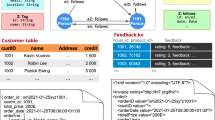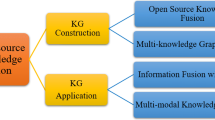Abstract
Currently, schema integration frameworks use approaches like rule-based, machine learning, etc. This paper presents an ontology-based wrapper-mediator framework that uses both the rule-based and machine learning strategies at the same time. The proposed framework uses global and local ontologies for resolving syntactic and semantic heterogeneity, and XML for interoperability. The concepts in the candidate schemas are merged on the basis of the similarity coefficient, which is calculated using the defined rules and the prior mappings stored in the case-base.
Similar content being viewed by others
References
Parent C, Spaccapieta S. Issues and approaches of database integration. Communications of the ACM., 1998, pp.166–178.
Neneventano D, Bergamaschi S, Guerra F et al. Synthesizing an integrated ontology. IEEE Internet Computing. IEEE Computer Society, Sept.–Oct. 2003, 7(5): 42–51.
Palopoli L, Sacca D, Ursino D. An automatic technique for detecting type conflicts in database schemas. In Proc. 7th Int. Conf. Information and Knowledge Management, Maryland, USA, 1998, pp.306–313.
Rahm E, Benrstein A P. A survey of approaches to automatic schema matching. The Int. J. Very Large Data Bases, 2001, 10(4): 334–350.
Madhavan J, Bernstein P A, Rahm E. Generic schema matching with Cupid. In Proc. the 27th International Conference on Very Large Data Bases, San Francisco, USA, 2001, pp.49–58.
Chawathe S, Molina H G, Hammer J et al. The TSIMMIS project: Integration of heterogeneous information sources. In Proc. IPSJ Conference, Tokyo, Japan, Oct. 1994, pp.7–18.
Do H, Rahm E. COMA — A system for flexible combination of schema matching approaches. In Proc. 28th Int. Conf. Very Large Databases (VLDB), Hongkong, Aug. 2002, pp.610–621.
Doan A, Domingos P, Levy A. Learning source descriptions for data integration. In Proc. the 3rd Int. Workshop on the Web and Databases (WebDB-2000), Dallas, May 18–19, 2000, pp.81–86.
Doan A, Domingos P, Halevy A. Reconciling schemas of disparate data sources: A machine-learning approach. In Proc. the 1997 ACM SIGMOD Int. Conf. Management of Data, California, USA, 2001, pp.509–520.
Doan A, Madhavan J, Dhamankar R et al. Learning to match ontologies on semantic web. The VLDB Journal — The International Journal on Very Large Data Bases, Nov. 2003, 12(4): 303–319.
Wache H, Vogele T, Visser U et al. Ontology-based integration of information—A survey of existing approaches. In Proc. IJCAI-01 Workshop: Ontologies and Information Sharing, Seattle, USA, Aug. 2001, pp.108–117.
Gruber T R. Toward principles for the design of ontologies used for knowledge sharing. Padua Workshop on Formal Ontology, Padua, Italy, March 1993.
Milo T, Zohar S. Using schema matching to simplify heterogeneous data translation. In Proc. the 24th Int. Conf. Very Large Data Bases, New York City, USA, 1998, pp.122–133.
Genesereth M R, Keller A M, Duschka O M. INFOMASTER: An information integration system. In Proc. the 1997 ACM SIGMOD Int. Conf. Management of Data, Arizona, USA, May 1997, pp.539–542.
Lawrence R, Barker K. Integrating relational database schemas using a standardized dictionary. In Proc. the 2001 ACM Symp. Applied Computing, Nevada, USA, 2001, pp.225–230.
Li W S, Chris Clifton. SEMINT: A tool for identifying attribute correspondences in heterogeneous databases using neural network. Data and Knowledge Engineering, April 2000, 33(1): 49–84.
Batini C, Lenzerini M, Navathe B S. A comparative analysis of methodologies for database schema integration. ACM Computing Surveys, December 1986, 18(4): 324–364.
Hakimpour F, Geppert A. Resolving semantic heterogeneity in schema integration: An ontology based approach. Conference on Formal Ontologies in Information Systems, Ogunquit, USA, October 17–19 2001, pp.297–308.
Ram S. A blackboard-based cooperative system for schema integration. IEEE Expert: Intelligent Systems and Their Applications, June 1995, 10(3): 56–62.
Wache H, Scholz T, Stieghahn H, Ries B K. An integration method for the specification of rule-oriented mediators. In International Symposium on Database Applications in Non-Traditional Environments (DANTE'99), Nov. 1999, p.109.
Author information
Authors and Affiliations
Corresponding author
Rights and permissions
About this article
Cite this article
Huma, Z., Rehman, M.JU. & Iftikhar, N. An Ontology-Based Framework for Semi-Automatic Schema Integration. J Comput Sci Technol 20, 788–796 (2005). https://doi.org/10.1007/s11390-005-0788-4
Received:
Revised:
Issue Date:
DOI: https://doi.org/10.1007/s11390-005-0788-4




